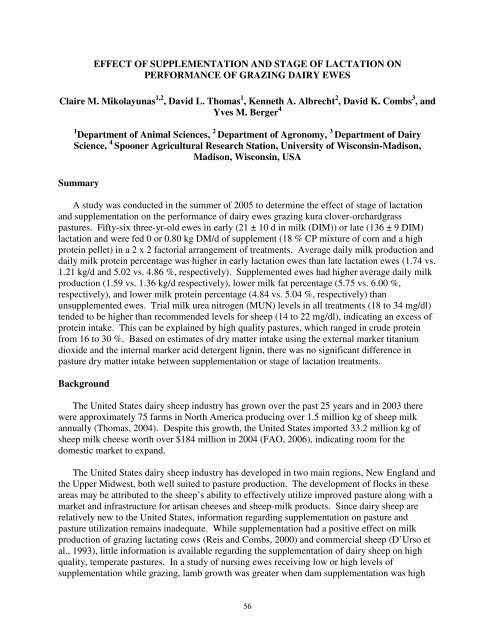great lakes dairy sheep symposium - the Department of Animal ...
great lakes dairy sheep symposium - the Department of Animal ...
great lakes dairy sheep symposium - the Department of Animal ...
Create successful ePaper yourself
Turn your PDF publications into a flip-book with our unique Google optimized e-Paper software.
EFFECT OF SUPPLEMENTATION AND STAGE OF LACTATION ON<br />
PERFORMANCE OF GRAZING DAIRY EWES<br />
Claire M. Mikolayunas 1,2 , David L. Thomas 1 , Kenneth A. Albrecht 2 , David K. Combs 3 , and<br />
Yves M. Berger 4<br />
1 <strong>Department</strong> <strong>of</strong> <strong>Animal</strong> Sciences, 2 <strong>Department</strong> <strong>of</strong> Agronomy, 3 <strong>Department</strong> <strong>of</strong> Dairy<br />
Science, 4 Spooner Agricultural Research Station, University <strong>of</strong> Wisconsin-Madison,<br />
Madison, Wisconsin, USA<br />
Summary<br />
A study was conducted in <strong>the</strong> summer <strong>of</strong> 2005 to determine <strong>the</strong> effect <strong>of</strong> stage <strong>of</strong> lactation<br />
and supplementation on <strong>the</strong> performance <strong>of</strong> <strong>dairy</strong> ewes grazing kura clover-orchardgrass<br />
pastures. Fifty-six three-yr-old ewes in early (21 ± 10 d in milk (DIM)) or late (136 ± 9 DIM)<br />
lactation and were fed 0 or 0.80 kg DM/d <strong>of</strong> supplement (18 % CP mixture <strong>of</strong> corn and a high<br />
protein pellet) in a 2 x 2 factorial arrangement <strong>of</strong> treatments. Average daily milk production and<br />
daily milk protein percentage was higher in early lactation ewes than late lactation ewes (1.74 vs.<br />
1.21 kg/d and 5.02 vs. 4.86 %, respectively). Supplemented ewes had higher average daily milk<br />
production (1.59 vs. 1.36 kg/d respectively), lower milk fat percentage (5.75 vs. 6.00 %,<br />
respectively), and lower milk protein percentage (4.84 vs. 5.04 %, respectively) than<br />
unsupplemented ewes. Trial milk urea nitrogen (MUN) levels in all treatments (18 to 34 mg/dl)<br />
tended to be higher than recommended levels for <strong>sheep</strong> (14 to 22 mg/dl), indicating an excess <strong>of</strong><br />
protein intake. This can be explained by high quality pastures, which ranged in crude protein<br />
from 16 to 30 %. Based on estimates <strong>of</strong> dry matter intake using <strong>the</strong> external marker titanium<br />
dioxide and <strong>the</strong> internal marker acid detergent lignin, <strong>the</strong>re was no significant difference in<br />
pasture dry matter intake between supplementation or stage <strong>of</strong> lactation treatments.<br />
Background<br />
The United States <strong>dairy</strong> <strong>sheep</strong> industry has grown over <strong>the</strong> past 25 years and in 2003 <strong>the</strong>re<br />
were approximately 75 farms in North America producing over 1.5 million kg <strong>of</strong> <strong>sheep</strong> milk<br />
annually (Thomas, 2004). Despite this growth, <strong>the</strong> United States imported 33.2 million kg <strong>of</strong><br />
<strong>sheep</strong> milk cheese worth over $184 million in 2004 (FAO, 2006), indicating room for <strong>the</strong><br />
domestic market to expand.<br />
The United States <strong>dairy</strong> <strong>sheep</strong> industry has developed in two main regions, New England and<br />
<strong>the</strong> Upper Midwest, both well suited to pasture production. The development <strong>of</strong> flocks in <strong>the</strong>se<br />
areas may be attributed to <strong>the</strong> <strong>sheep</strong>’s ability to effectively utilize improved pasture along with a<br />
market and infrastructure for artisan cheeses and <strong>sheep</strong>-milk products. Since <strong>dairy</strong> <strong>sheep</strong> are<br />
relatively new to <strong>the</strong> United States, information regarding supplementation on pasture and<br />
pasture utilization remains inadequate. While supplementation had a positive effect on milk<br />
production <strong>of</strong> grazing lactating cows (Reis and Combs, 2000) and commercial <strong>sheep</strong> (D’Urso et<br />
al., 1993), little information is available regarding <strong>the</strong> supplementation <strong>of</strong> <strong>dairy</strong> <strong>sheep</strong> on high<br />
quality, temperate pastures. In a study <strong>of</strong> nursing ewes receiving low or high levels <strong>of</strong><br />
supplementation while grazing, lamb growth was <strong>great</strong>er when dam supplementation was high<br />
56
















